
Do you have a question about the Carrier 50TC-D25 and is the answer not in the manual?
| Type | Split System |
|---|---|
| Refrigerant | R-410A |
| Operating Voltage | 208/230V |
| Phase | 1 |
| Sound Level (Outdoor) | 72 dB(A) |
Discusses hazards, safety codes, signal words (DANGER, WARNING, CAUTION, NOTICE).
Details various hazards like cut, damage, fire, electrical shock, and operational safety.
Explains how the SAV system uses VFD to adjust fan speed for different operating modes.
Introduces the system's capability for multiple humidity control modes.
Provides diagrams illustrating refrigerant flow in Normal, Subcooling (Reheat 1), and Hot Gas Reheat (Reheat 2) modes.
Provides a table of common problems, causes, and remedies for the Humidi-MiZer system.
Step-by-step instructions for replacing the TXV, including safety precautions and refrigerant handling.
Outlines steps for preparing the unit for refrigerant charge adjustment.
Provides graphical charts for determining correct refrigerant charge based on suction temperature and pressure.
Warns about POE oil's hygroscopic nature and avoiding atmospheric exposure.
A table listing common cooling system problems, their causes, and recommended remedies.
Warns about electrical hazards related to convenience outlets and the need for lockout/tagout.
Details the wiring and response logic for FIOP smoke detectors, including PremierLink and RTU-Open integration.
Provides a diagram illustrating the wiring for the smoke detector system.
Procedures for testing sensor and controller alarm/trouble states and dirty status.
Details compressor protection mechanisms like overcurrent, overtemperature, and high-pressure switch.
Explains the function of the low-pressure switch for charge loss protection.
Guides on diagnosing issues when the controller's Trouble LED is on or flashing.
Steps for diagnosing issues when a sensor's Trouble LED is on.
Steps for diagnosing issues when a sensor's Power LED is off.
Steps for diagnosing issues when a controller's Power LED is off.
Guides on issues with remote test/reset station trouble LED.
Details motor protection devices like internal protection and external overload breakers.
Explains common causes for supply fan motor overload trips.
Introduces the PremierLink controller and its sensors.
Details the PremierLink controller's compatibility, mounting, and included sensors.
Explains the controller's integrated application programming for performance and efficiency.
Warns of electrical hazards during RTU-OPEN controller wiring.
Refers to specific manuals for detailed installation and troubleshooting information.
Provides a detailed diagram of the RTU-OPEN control module with terminal connections.
A table summarizing the input/output logic for the EconoMi$er IV system.
Explains the different control modes available for the EconoMi$er IV.
Discusses DCV criteria, calculation of ventilation rates, and CO2 sensor integration.
General warnings about safety practices, PPE, and refrigerant handling during checks.
Electrical safety warnings regarding grounding and NEC compliance.
Checks to perform before initial start-up, including shipping damage and installation verification.
Details how to check and verify compressor rotation direction.
Steps to start the unit in cooling mode, set thermostat, and check charge.
Warning about electrical hazards and grounding requirements.
Instructions for starting up and configuring the PremierLink controller using Carrier software.
Refers to manuals for RTU-OPEN controller installation, wiring, and troubleshooting.
A table listing wiring diagram part numbers for different unit sizes and options.
Wiring diagram for STD TIER PAC Control.
Wiring diagram for STD TIER PAC Control (460V/575V 3 PH).
Power diagram for 50TC units with Humidi-MiZer.
Power diagram for 50TC units with Humidi-MiZer (460/575V 3 PH).
Power diagram for 50TC units with Dehumidification.
Power diagram for 50TC units with Dehumidification (460/575V 3 PH).
Power diagram for 50TC units with Humidi-MiZer.
Power diagram for 50TC units with Humidi-MiZer (460-3-60).
Power diagram for 50TC units with Humidi-MiZer (575-3-60).
Wiring diagram for the PremierLink system control.
A checklist of pre-start-up inspections required before unit operation.
Checks for supply voltage, compressor amps, and fan amps.
Measurements for outdoor, return, and supply air temperatures, and system pressures.





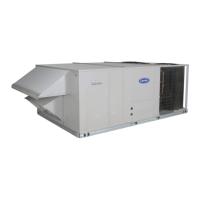
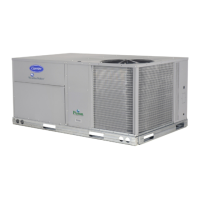
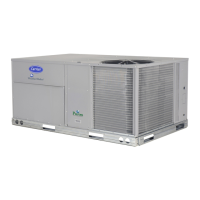
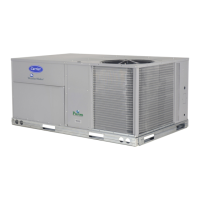
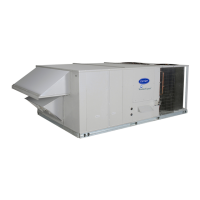
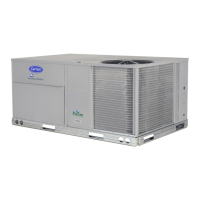
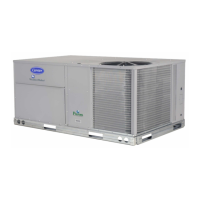
